Floating Villages
8 May 06
Siem Reap, Cambodia
...
Floating Villages of Tonle Sap
...
We're packing out today and heading on a fast boat 'cruise' along the Tonle Sap (Cambodia's Prize Lake). We stop by a tour agency in Siem Reap to purchase 'cruise' tickets in advance (our driver says that it's much cheaper that way and the boat drivers must abide by our schedule). Then we drive the 20 minute stretch out to the channel where we board the boats. Because it's dry season, the lake is much lower than normal and the boat dock is 5km further away than usual.
The river and lake is currently about 1/2m deep but during the inundation period it rises some 13m!!! There are entire villages that are set up on the dry land that will flood in a few months when the rains return. We board our boat and set sail.
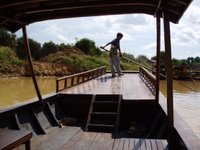

We speed out toward toward the Floating Villages of Chong Kneas with our boat driver Toeps and his young assistant Peron. Toeps is in high school, speaks impeccable English and earns his tuition money for his half day classes by leading boat tours in the morning. His father died about 5 years ago and he's the head of household for his extended family. Driving out to the boat dock, we passed several villages that were beyond impoverished. The homes are nothing but simple grass shacks built on stilts with leaf-thatched roofs. It appears their only possessions are a few plastic bowls, a hammock and some linens. Toeps explains to us that his 'mate' Peron works for free--training to one day be able to lead these boat tours himself. Peron appears to be about 8 years old.


We cruise along a dredged canal on our way out to Tonle Sap. We pass by several floating schools along the way to the lake that have been 'sponsored' by various countries--we see schools built by South Korea and Japan.
This school was built by South Koreans--it's one of 3 floating schools we see with the Korean 'Pal Kwai' (South Korean flag) on a plaque on its side. The schools are about 100m x 25m and are filled to the rim with children.
Here's the floating school that was built by the Japanese. It seems to have a gymnasium built on the second floor. It also had computers in it! It really outshone the other schools in the area. It's also where all the students would like to attend school but tuition is more expensive there--so it all depends upon how much money the children earn during the day that determines which school they attend. I keep wondering if school children in the US had to earn their own tuition money if perhaps they wouldn't take education for granted? This experience really drives home the point that education is a precious commodity!
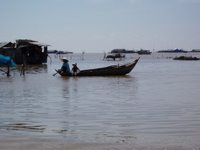

We make it out to the middle of the lake and sail through the villages. We see shacks, boats, cat fish pens, floating pig pens, a Vietnamese Catholic Church--you name it. It's amazing to think that entire villages actually live on this lake! It reminds me that back home we've had a landscaped pond in our backyard for the past 6 years--but because we had young children we never filled it with water. I can't even imagine raising a toddler on a floating shack!!!
This is a catfish pen--where residents corral their catch until it's time to either sell them or prepare their next meal.
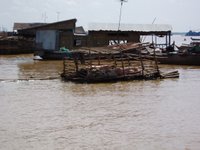

Here's a child who floated by us in a metal bowl. I've never seen something like this before!
Eventually we sail out to a giant 'floating restaurant' where we step off our boat onto the larger boat. Here we find giant pens containing serpent fish (a delicacy around Cambodia) and crocodiles. Hundreds and hundreds of crocodiles.
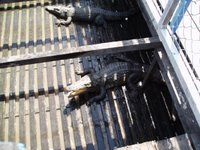

I couldn't remember if they sleep with their mouths open to let those birds clean their teeth like we studied about in the Nile region or if they just normally sleep that way. Regardless it's quite different from how we saw the alligators sleep down in Louisiana's bayous. They kept their mouths closed down there. Anyway, these crocodiles are stored here as food for the restaurant. I've tasted alligator before but never crocodile. I wasn't really in the mood for croc-on-a-stick today, though. ;)
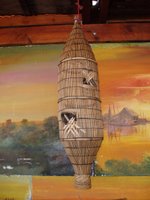

Here's a family photo from atop the floating restaurant. You can see a few dozen of the floating shacks behind us.
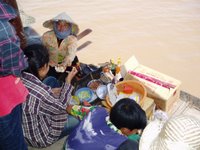

A small boat bearing a Vietnamese woman who was selling baguettes filled with pork and vegetable mixture floated by. Her food looked scrumptious but I was still stuffed from breakfast so we passed on the meal. The floating villages actually incorporate 3 different ethnicities of people: Cambodian, Thai & Vietnamese. They're nomadic in that they move around based on the fish supply and the water depth at various times of the year. Tonle Sap almost doubles in size between the dry and wet seasons each year. It's fed by the Mekong River and in the dry season the water flows out (South) of the Tonle Sap into the Mekong River Delta--during the wet season the direction of the Mekong River changes and the water flows North towards Hanoi. Very interesting!
...
The air is much cooler on the lake and is a very welcome change from the heat and dust that we experienced while exploring the temples the past couple of days. We see lots of interesting birds during our outing including Great Egrets, Cormorants Indien, Whiskered Terns, Kingfishers, etc. Along the way we see various things in the floating villages--including a Korean restaurant off in the distance. We originally intended to make an additional 2-hour trek to visit the Flooded Forest of Kompong Phhluk but realize that we're quickly running out of time before we must catch our flight--gotta save something for our next trip to Cambodia, right? The attraction at Kompong Phluuk is its flooded forest and its other-worldy village built on bamboo stilts. These homes are built on stilts that are 6-7m tall! During the inundation season, it takes about 40 minutes to reach this village as you can taxi most of the stretch in your boat but during the dry season you must hop off the boat and then hike in 3km to reach the bamboo stilt village. Because we're pressed for time, we opt to forego this experience and take a more leisurely trip back to Siem Reap.
When we finish our boat tour, we return to our taxi and drive back toward Siem Reap. We pass this 'luxury' home on stilts along the way. It's leaps & bounds more luxurious than most of the other shacks we pass by along the drive.


We also see these open air restaurants that have tables & seats in the front and then large open areas with dozens of hammocks stretched out on the back side of the platforms. Apparently these restaurants encourage folks to take their siestas there on the hammocks after they eat. What an interesting concept!
...
We also pass by a large water lily farm with lots of lotus blossoms blooming on the surface of the water. We continue to pass by numerous rustic villages along the dirt road back to Siem Reap. We pass more grass huts intermixed with large villas. Trekkie even notices a large elevated pig & cattle pen in the village just outside of the boat canal. He thinks the livestock are kept in those elevated pens so they never get used to being on land. We also see a large water wheel in the stream along the way that's propelled by the light trickle of the stream.
...
Our next stop along the way is the Akira Land Mine Museum back on the edge of town.

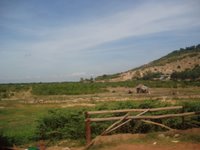

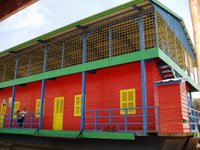
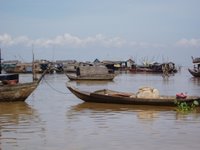
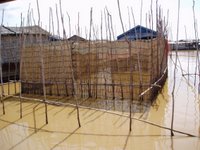
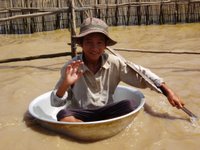

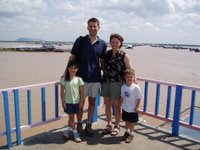
0 Comments:
Post a Comment
<< Home